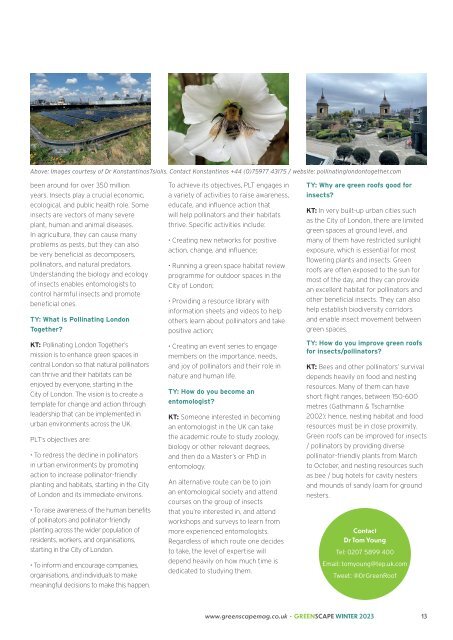Winter 2023
You also want an ePaper? Increase the reach of your titles
YUMPU automatically turns print PDFs into web optimized ePapers that Google loves.
Above: Images courtesy of Dr KonstantinosTsiolis. Contact Konstantinos +44 (0)75977 43175 / website: pollinatinglondontogether.com<br />
been around for over 350 million<br />
years. Insects play a crucial economic,<br />
ecological, and public health role. Some<br />
insects are vectors of many severe<br />
plant, human and animal diseases.<br />
In agriculture, they can cause many<br />
problems as pests, but they can also<br />
be very beneficial as decomposers,<br />
pollinators, and natural predators.<br />
Understanding the biology and ecology<br />
of insects enables entomologists to<br />
control harmful insects and promote<br />
beneficial ones.<br />
TY: What is Pollinating London<br />
Together?<br />
KT: Pollinating London Together’s<br />
mission is to enhance green spaces in<br />
central London so that natural pollinators<br />
can thrive and their habitats can be<br />
enjoyed by everyone, starting in the<br />
City of London. The vision is to create a<br />
template for change and action through<br />
leadership that can be implemented in<br />
urban environments across the UK.<br />
PLT’s objectives are:<br />
• To redress the decline in pollinators<br />
in urban environments by promoting<br />
action to increase pollinator-friendly<br />
planting and habitats, starting in the City<br />
of London and its immediate environs.<br />
• To raise awareness of the human benefits<br />
of pollinators and pollinator-friendly<br />
planting across the wider population of<br />
residents, workers, and organisations,<br />
starting in the City of London.<br />
• To inform and encourage companies,<br />
organisations, and individuals to make<br />
meaningful decisions to make this happen.<br />
To achieve its objectives, PLT engages in<br />
a variety of activities to raise awareness,<br />
educate, and influence action that<br />
will help pollinators and their habitats<br />
thrive. Specific activities include:<br />
• Creating new networks for positive<br />
action, change, and influence;<br />
• Running a green space habitat review<br />
programme for outdoor spaces in the<br />
City of London;<br />
• Providing a resource library with<br />
information sheets and videos to help<br />
others learn about pollinators and take<br />
positive action;<br />
• Creating an event series to engage<br />
members on the importance, needs,<br />
and joy of pollinators and their role in<br />
nature and human life.<br />
TY: How do you become an<br />
entomologist?<br />
KT: Someone interested in becoming<br />
an entomologist in the UK can take<br />
the academic route to study zoology,<br />
biology or other relevant degrees,<br />
and then do a Master’s or PhD in<br />
entomology.<br />
An alternative route can be to join<br />
an entomological society and attend<br />
courses on the group of insects<br />
that you’re interested in, and attend<br />
workshops and surveys to learn from<br />
more experienced entomologists.<br />
Regardless of which route one decides<br />
to take, the level of expertise will<br />
depend heavily on how much time is<br />
dedicated to studying them.<br />
TY: Why are green roofs good for<br />
insects?<br />
KT: In very built-up urban cities such<br />
as the City of London, there are limited<br />
green spaces at ground level, and<br />
many of them have restricted sunlight<br />
exposure, which is essential for most<br />
flowering plants and insects. Green<br />
roofs are often exposed to the sun for<br />
most of the day, and they can provide<br />
an excellent habitat for pollinators and<br />
other beneficial insects. They can also<br />
help establish biodiversity corridors<br />
and enable insect movement between<br />
green spaces.<br />
TY: How do you improve green roofs<br />
for insects/pollinators?<br />
KT: Bees and other pollinators’ survival<br />
depends heavily on food and nesting<br />
resources. Many of them can have<br />
short flight ranges, between 150-600<br />
metres (Gathmann & Tscharntke<br />
2002); hence, nesting habitat and food<br />
resources must be in close proximity.<br />
Green roofs can be improved for insects<br />
/ pollinators by providing diverse<br />
pollinator-friendly plants from March<br />
to October, and nesting resources such<br />
as bee / bug hotels for cavity nesters<br />
and mounds of sandy loam for ground<br />
nesters.<br />
Contact<br />
Dr Tom Young<br />
Tel: 0207 5899 400<br />
Email: tomyoung@tep.uk.com<br />
Tweet: @DrGreenRoof<br />
www.greenscapemag.co.uk • GREENSCAPE WINTER <strong>2023</strong> 13

















